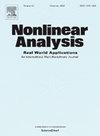宿主-病原体协同进化模型,第一部分:直奔你的生活
IF 1.8
3区 数学
Q1 MATHEMATICS, APPLIED
引用次数: 0
摘要
在这项研究中,我们提出了一个新的模型,描述宿主和病原体之间的共同进化,基于非局部偏微分方程的形式,由表型性状组成的群体。我们的目标是用这个模型来说明与“追逐红皇后场景”的进化概念相对应的场景,其特征是宿主和病原体之间不断的进化追逐。首先,数值模拟显示了这种情况的出现,描绘了病原体追赶宿主(在表型空间)的逃逸。我们观察到两种类型的行为,这取决于宿主存在最佳表型的假设:要么形成以恒定速度和恒定轮廓沿直线移动的行进脉冲,要么在表型空间中沿圆周周期性旋转的稳定表型分布。通过严格的摄动技术和隐函数定理在相当复杂的函数空间中的仔细应用,我们证明了第一类行为的存在性,即沿直线匀速运动的脉冲。正如Lotka-Volterra模型揭示了不需要环境强迫的周期性动力学一样,我们的工作表明,从病原体的角度来看,各种移动最优的轨迹可以从与宿主物种的共同进化中出现。本文章由计算机程序翻译,如有差异,请以英文原文为准。
A host-pathogen coevolution model, Part I: Run straight for your life
In this study, we propose a novel model describing the coevolution between hosts and pathogens, based on a non-local partial differential equation formalism for populations structured by phenotypic traits. Our objective with this model is to illustrate scenarios corresponding to the evolutionary concept of “Chase Red Queen scenario”, characterized by perpetual evolutionary chases between hosts and pathogens. First, numerical simulations show the emergence of such scenarios, depicting the escape of the host (in phenotypic space) pursued by the pathogen. We observe two types of behaviors, depending on the assumption about the presence of a phenotypic optimum for the host: either the formation of traveling pulses moving along a straight line with constant speed and constant profiles, or stable phenotypic distributions that periodically rotate along a circle in the phenotypic space. Through rigorous perturbation techniques and careful application of the implicit function theorem in rather intricate function spaces, we demonstrate the existence of the first type of behavior, namely traveling pulses moving with constant speed along a straight line. Just as the Lotka–Volterra models have revealed periodic dynamics without the need for environmental forcing, our work shows that, from the pathogen’s point of view, various trajectories of mobile optima can emerge from coevolution with a host species.
求助全文
通过发布文献求助,成功后即可免费获取论文全文。
去求助
来源期刊
CiteScore
3.80
自引率
5.00%
发文量
176
审稿时长
59 days
期刊介绍:
Nonlinear Analysis: Real World Applications welcomes all research articles of the highest quality with special emphasis on applying techniques of nonlinear analysis to model and to treat nonlinear phenomena with which nature confronts us. Coverage of applications includes any branch of science and technology such as solid and fluid mechanics, material science, mathematical biology and chemistry, control theory, and inverse problems.
The aim of Nonlinear Analysis: Real World Applications is to publish articles which are predominantly devoted to employing methods and techniques from analysis, including partial differential equations, functional analysis, dynamical systems and evolution equations, calculus of variations, and bifurcations theory.

 求助内容:
求助内容: 应助结果提醒方式:
应助结果提醒方式:


